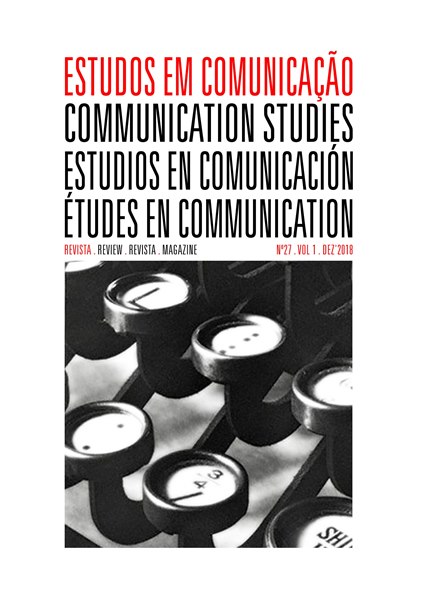Jornalismo 3.0: o impacto dos agregadores de notícias online no negócio da informação
Keywords:
Agregadores de notícias, web 3.0, Portugal, jornalismo, convergência, modelos de negócioAbstract
In the last years, the information market has been reconfigured in terms of business model, consumption, production and circulation of news content. These changes were provided by a technological convergence marked by the digitalization of media and dissemination
of contents. Today, the journalism in Portugal is facing a 3.0 environment marked by the popularization of the internet, and the crucial role that the citizen plays in the News distributing process. The purpose of this article is to investigate how these current changes in the media market are perceived by the main agents of business information, as news aggregators, digital and outlet media. The results show that aggregators provide more visibility and attractiveness of new audiences and increase
new forms of news distributing enhancing the brand and not appropriating it. On the other hand, their dependence is perceived as a disadvantage because the media can no longer survive without the aggregator, losing the value of their brand. It’s created a distrust relationship, to the detriment of the media themselves or by compromising the return of the media. They are dependent, independently of the return they get from this alliance.
References
Athley, S. & Mobius, M. (2012). The Impact of News Aggregators on Internet News Consumption: The Case of Localization.
Bakker, P. (2012). New journalism 3.0: Aggregation, Content farms and Huffinization: the rise of low-pay and no-pay Journalism. Hogeschool Utrecht: University of Amsterdam.
Bardin, L. (1977). Análise de Conteúdo (trad. L. A. Reta & A. P. Capa). Lisboa: Edições 70.
Bolt, J. & Grusin, R. (1999). Remediation: understanding the new media. University of United States of America.
Cagé, J. (2016). Salvar os Média. Lisboa: Temas e Debates – Círculo de Leitores.
Cardoso, G. et al (2015). A sociedade em rede em Portugal - Uma Década de Transição. Coimbra: Almedina.
Creswell, J. (2007). Projeto de pesquisa: métodos quantitativos, qualitativos e misto. São Paulo: ARTMED.
Deuze, M. (2006). Liquid Journalism. Indiana: USA.
Deuze, M. (2007). Liquid Journalism. Disponível em http://deuze.blogspot.pt/2007/05/moreliquid-
journalism.html. Consultado a 28-02-2016.
Deuze, M. (2008). The Changing Context of News Work: Liquid Journalism and Monitorial Citizenship.
ERC (2015). Digital Media Portugal. Disponível em www.erc.pt/download/YToyOntzOjg6ImZpY
hlaXJvIjtzOjM4OiJtZWRpYS9lc3R1ZG9zL29iamVjdG9fb2ZmbGluZS83OS4xLnBkZiI7
czo2OiJ0aXR1bG8iO3M6Mjc6ImRpZ2l0YWwtbWVkaWEtcG9ydHVnYWwtMjAxNSI7f
Q==/digital-media-portugal-2015. Consultado a 15-01-2016.
Fenton, N. (2010). New Media, Journalism and Democracy: Figments of a Neo- Liberal Imagination?. Revista Media & Jornalismo, (17): 41-52. Lisboa: Edição Mariposa Azual.
Foust, J. C. (2005). Online Journalism: principles and practices of news for the web. Holcomb Hathaway: USA.
Guerrini, F. (2013). Newsrom curators & Independent Storytellers: Content Curation as a New Form of Journalism. Reuters Institute for the Study of Journalism: University of Oxford.
Google (s.d.). Notícias. Disponível em https://news.google.pt/. Consultado em 02-12-2015.
Holton, A.E. (2010). Negating Nodes and Fifth-Stage Fragmentation. New applications of traditional
communication models and theories in the midst of diffusing communication innovations. New Media Theory: How far Have We Traveled? (pp. 1-27). Texas Tech University, College of Mass Communications.
Homepage do Sapo.pt (s.d.). Disponível em www.sapo.pt/. Consultado a 01-12-2015.
Jenkins et al. (2013). Spreadable media: creating value and meaning in a networked culture. New York: University Press.
Lee, A. M. & Chyi, H. I. (2015). The Rise of online news aggregators: consumption and competition. International Journal on Media Management.
Lee, A. M. & Chyi, H. I. (2012). Theorizing Online News Consumption: A Structural Model Linking Preference, Use, and Paying Intent. Paper presented at the 13th International Symposium on Online Journalism, Austin, TX, April 20-21, 2012.
Lopes, F. (2015). Jornalista: Profissão Ameaçada. Lisboa: Alêtheia Editores.
Maxwell, J. (2005). Qualitative Research Design: an interactive approach. Thousand Oaks; London; New Delhi: Sage.
MSN notícias Portugal (s.d.). Disponível em www.msn.com/pt-pt. Consultado a 02-12-2015.
Patterson, C. & Domingo, D. (2008). Making online news. New York: Peter Lang.
Prior, M. (2005). News vs. Entertainment: How increasing media choice widens gaps in political knowledge and turnout. American Journal of Political Science, 49(3).
PucRio (s.d.). Metodologia de Maxwell. Disponível em www.maxwell.vrac.puc-rio.br/9443/9443
_4.PDF. Consultado a 17-04-2016.
Turner, G. (2010). Ordinary People: celebrity, tabloid culture, and the function of the media. Ordinary People and the Media: The Demotic Turn (pp. 12-32). London: Sage.
Usher, N. (2014). Making News at the New York Times. Ann Arbor: The University of Michigan Press.
Downloads
Published
Issue
Section
License
Estudos em Comunicação/Communication Studies is an Open Access journal. All its content is freely available without charge to the user or his institution. Users are allowed to read, download, copy, distribute, print, search, or link to the full texts of the articles in this journal without asking prior permission from the publisher or the author. Estudos em Comunicação, by Labcom, is licensed under a Creative Commons Atribuição-NãoComercial-SemDerivações 3.0 Unported License. By submitting your work to Estudos em Comunicação/Communication studies you confirm you are the author and own the copyright, that the content is original and previously unpublished, and that you agree to the licensing terms.


